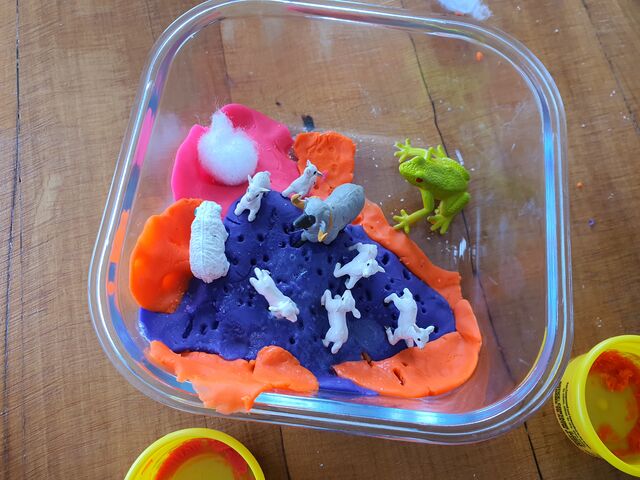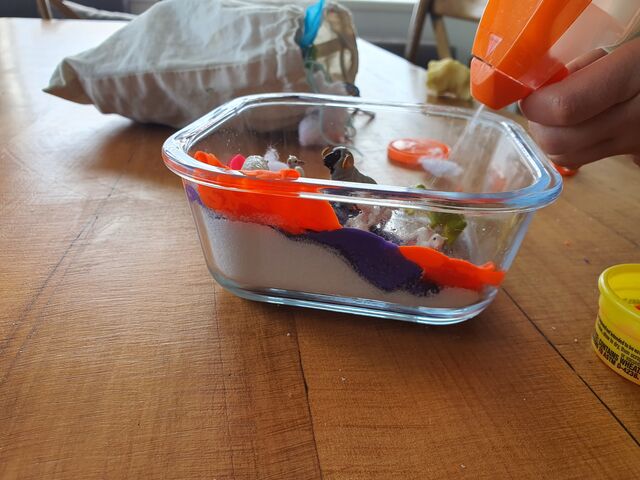Watch this marvelously magical time-lapse of glowworms inside Waitomo Caves. Maybe you could create the same effect in your cave using tinsel or a pipe-cleaner crystal that you made in Crystal Magician...!
Find out how caves are made in nature by making your own Gollum’s grotto or real-life Minecraft cavern!
What to do
Your mission is:
Instructions
1. WATCH THIS!
2. A SWEET CAVE
Get your sugar cubes (don't eat them – you'll need them!) and container.
Decide on what shape you want your cavern to take and build it ‘inside out’ by piling up sugar cubes. Make sure they line up against the side of the container.
3. CLAY COVER
Mould modeling clay 2-3cm deep over the top of the sugar cubes to make the earth and base layer for the landscape. Seal it tightly.

4. GROOM FOR IMPROVEMENT!
Go wild decorating your above-ground landscape! Maybe make your own Misty Mountain, or fence yourself up a farm.
You can load it up with plants, grass, and animals – cows and kiwis or robots and unicorns!
5. HOLEY CLAY!
Carefully stick some holes through the clay layer on top of the sugar cubes using a toothpick (or a knitting needle – preferably one without a scarf or your Nana attached to it).
Make sure the holes go all the way through the clay to the sugar cubes.
6. WATER WORKS
Spray warm water over the holes and let it seep on through …
(Note: it can take quite a bit of water, so keep working that spray bottle or water sprinkler.)

7. HIDEY-HOLE
Watch the water on its journey to dissolve the sugar cubes and reveal your hidden chamber!
Tip #1: adding food dye to the water makes the sweet-as sugary disappearing act easier to see.
Tip #2: if there's too much water, get an adult to drill a hole in the container's bottom corner, drain out the water and voila: DIY CAVE!

8. UPLOAD TO THE JUDGES
When your cave is cool, take a photo and upload to Wild Eyes. You have made a wonder of nature. Mega caves like Waitomo in the North Island took thousands of years to dissolve; your cave takes just an afternoon! Think about that – and kids: don't eat too much sugar!
INDIANA BONES
Think out of the box inside the box: could you make your own stalagmites or stalactites or a hanging garden of glow-worms (try tinsel or pipe-cleaner crystals you made in Crystal Magician!) …
Or create your own archaeological site: moa and pouakai (giant eagle) bones have been discovered in caves after the unlucky birds fell through holes in the ground (called 'tomo') and couldn't get out. You could use chicken or fish bones and use the photo of your fake fossils for Fake a Giant Moa Discovery!
What's happening?
HOW CAVES ARE MADE
First off, caves aren’t built – they’re dissolved! It all kicks off when rainwater mixes with carbon dioxide in the air as it falls to the ground.
The carbon dioxide makes the rain become slightly acidic.

– Mum when do I get my own room??
Rain vs rock

Sink holes in South Canterbury caused by acidic water dissolving limestone in the ground.
As rainwater trickles through soil into the ground, it picks up more carbon dioxide from dead plants. Eventually the water comes to solid rock. If this rock is limestone or dolomite – BOOM! A cave can be born.
(But it’s gonna take a while… we’re talking centuries rather than Snapchat time!)
DISSOLVING THE PUZZLE
The water reacts chemically with limestone and slowly dissolves it, opening up a hollow space which over time gets bigger and bigger to eventually make a cave – a process called 'chemical erosion'.
In your Wild Eyes cave-making activity, the sugar cubes are dissolved by the water to demonstrate the way limestone dissolves IRL!
THE WAITING GAME
As the space becomes larger and larger the water can flow through, which makes the cave grow even more as the water washes away rock and sand.
This is also how underground streams can form. Next, set your alarm and come back after hundreds of thousands of years to find your stadium-sized cave. Catch you then!
Inspiration
GLOWWORM BLING
THE POINTY BITS
Stalactite ...? Stalagmite ...?
Both are those strange pointy formations found growing from the ground and hanging from the ceiling in limestone caves.
One points up, the other points down... but which is which? Here’s the secret: stalactite has to hang on tight-ly and has a “c” in it (as in “ceiling,”) and stalagmite has a “g” in it, as in “ground.”
Together forever
When water flows down through cracks in the the ground into a cave, it dissolves a mineral called calcite. The calcite slowly builds up on the ceiling of the cave until a stalactite takes shape, hanging down like an icicle.
Drops of calcite in water, dripping from the end of the stalactite, leave more calcite on the cave floor, and pretty soon a cone-like stalagmite takes shape from the ground up – which is why stalactites and stalagmites are usually found in pairs! Left alone long enough, they sometimes grow together to form a column: it was meant to be!
THAT'S DEEP MAN
New Zealand has a few sweet spots for adventurers wanting to suss out the deep underground: world famous caverns such as Waitomo, Mt Owen and Mt Arthur.
Nettlebed Cave on Mt Arthur has a total depth of 889 metres: that’s nearly a whole kilometre underground! You wouldn’t wanna drop your camera…
OLD SCHOOL TAGGING
Way back in the day, Māori had a whole bunch of uses for caves, which were often tapu (sacred) spaces.
They would take shelter in them, use them as burial sites, and also draw pictographs on the walls (kind of like movies before they moved!).
What will be on your cave wall when the sugar dissolves? A bat signal? A cave weta?
WETA CAVE
Not many creatures live in caves because of the lack of light. One that does is the cave wetā. They might look freaky but they're harmless: silent, deaf and with no teeth: coming out at night to forage on plants, fungi and dead insects on the floor around cave entrances ...
They have long antennae and can leap impressive heights with their long jumper legs – up to 2m: that's higher than Stephen Adams!!





































